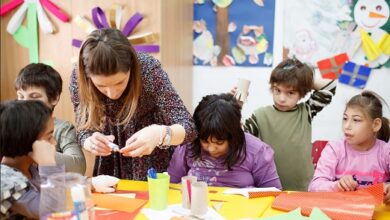What is Recreational Games and physical education with 15 Examples
Recreational Games
The term recreational games refers to any activity that aims to enjoy leisure time. Thus, productive activities can oppose recreational games, as they are necessary for their own maintenance and for the whole society ; recreational activities, on the other hand, take place at leisure and serve to put boredom aside . However, what is intended is to find an intermediate place between a productive and an unproductive activity for these types of games. In fact, they are used to alleviate everyday fatigue and stress.
Recreational games have been around since the dawn of man. They can take many forms, but require establishment rules for a player to interact and submit to voluntary limitations. These games can be individual or collective, and in history, collectives predominate over individual ones, sometimes even becoming a reason of social importance to participate in the main events. Undoubtedly, the case of group sports can be a good example in this regard, as it brings together people who are divided into groups and who have goals to fulfill within pre-established rules.
Collective games, in turn, can be observed in two senses: being competitive or cooperative. In the first case, we can refer again to the example of sports such as football, volleyball, basketball, etc. In the second, there are computer games or video games that enable the possibility of the participation of two or more players in the dispute.
It is worth noting that it is not just human beings who frequently participate in games; it is very common to find the participation of animals, especially puppies. These practices are generally understood as ways of learning their motor skills and that will serve them in the future. Fight simulators are also explained as a way of learning.
Recreational games serve as a form of relaxation in the face of the vicissitudes of life that cause stress. That’s why it’s recommended to give a small amount of time to the day’s activities, of course within a limit.
Recreational games and physical education
Within the scope of physical education, recreational games are often associated with sports such as football, futsal, volleyball and basketball.
Despite this, recreational games are often not sports, because they do not have a competitive aspect, and the most important thing is not to win, but to participate and have fun.
Recreational games in Early Childhood Education
Recreational games play a very important role for children between 0 and 6 years old and also for elementary school children.
Playful activities provide children with psychomotor (cognitive and physical) development, facilitating the learning of the content that is part of the stipulated program. The advantage is that learning occurs while the child is having fun.
When played in groups, recreational games improve the sense of cooperation because they encourage teamwork, something essential in many jobs.
The 15 most relevant recreational games
1- Hide and Seek
Ideally, it is played with at least three people. The general idea is for a person to close their eyes and count to a certain number (from 10 to 100) without looking. When you’re done, you should try to find the other participants.
This game has many variations. Sometimes there is a base of operations that participants can run around to avoid being found, whereas in most versions you just hide and wait to be found.
2- Capture the flag
Usually played in a large group. First, the group is divided into two teams, each of which must have a flag or marker at the team’s central base.
The objective of the game is to rush into the opposing team’s territory to steal or capture their flag and take it back to the base.
You can tag “enemy” players who are in your own territory to “send them to jail”.
They can be released if a member of your team runs into the opposite territory, tags them, and reaches the base safely.
3- Traffic police
This game is played on a street with little traffic or in an area with a sidewalk. Bicycles, wheelbarrows, skateboards and skateboards or something with wheels are necessary. Some act as drivers and others as pedestrians; The latter must cross the street.
The idea is for one person to direct traffic so that people don’t collide with each other.
4- Four squares
This ball game is played on a square court divided into four smaller squares, listed one through four.
One player stands on each of the four squares; The ball must be returned between players by bouncing it once in the person’s square before they catch it.
There are many rules that can be added. For example, the person at square one may be responsible for creating the rules.
Whoever violates them will be degraded and will move to the last square (the fourth) or be eliminated.
You can also add the rule that the ball must be returned twice before catching it, that it must only be returned in front of the person, or other rules. The rules vary according to creativity.
5- Hopscotch
You must first make a hopscotch grid with chalk on the floor; squares one through nine must be listed. A stone that can be thrown is chosen. The stone must be thrown into square number one.
Then jump onto the rock and jump with one foot or both feet, as indicated by the hopscotch pattern, to the end.
Then, you need to turn around and go back, stopping at square number two. Balancing on one foot, you pick up the rock from square one and jump to begin.
You should continue this pattern with square number two and so on. If the stone is thrown and lands in the wrong square, the turn is lost.
6- Monkeys (Matata)
The player spreads the jacks or matatenas on the playing surface as if he were rolling some dice.
Then the ball is thrown. You are only allowed to jump once and grab it before you can jump a second time.
The player must catch the jacks and carry the ball with one hand before the ball bounces twice.
The number of matatenas that must be collected is increased: first it is taken, then two, then three and so on.
7- red light, green light
One person represents the traffic light and stands on one side, and the other players go on the opposite side; the person at the traffic lights must turn and turn their back to them.
When the traffic light approaches people and shouts “red light”, all people must remain stopped.
The traffic light is turned backwards again and says “green light”, while the group tries to get as close to the traffic light as possible.
The idea is that the light turns on quickly and shouts “red light” so that everyone freezes. If a person moves, he must return to the starting location and start the journey again.
The first person to touch the traffic light wins and becomes the traffic light for the next turn.
8- Simon says
One person starts by saying “Simon says (insert any action here)” and everyone must take that action.
However, if Simon starts saying an action without saying “Simon says”, anyone who performs it is out of the game. The last person left at the end of the game will be Simon from the next turn.
9- The stain or the error
A group of people decides who will start to be the error or spot. That person must then chase the rest of the group, trying to touch them with their hand. The new person you touch becomes the new error or spot.
The rule is often placed that there are no marks in a row, meaning that a person cannot touch the person who just turned them into the mistake.
10- Blind spot
It is a variation of the stain. The person who is the spot must cover their eyes with a scarf and chase the players and try to mark them without seeing them.
11- Button, button, who has the button
Start with a group sitting or standing around a circle; everyone must have their hands together in front of the body.
One person takes the button and goes around the circle, pretending to place it in someone’s hands.
The idea is to place the button in one person’s hands, but then continue going around the circle, pretending to place the button in everyone’s hands; This way, no one knows where the button is.
When finished, each person stops and tries to determine who has the button. Before the person guesses, the group must sing, “Button, button, who has the button,” and then the person says who they think has it.
After guessing who has the button, that person hands it out in the next round.
A variation of the game is that one person stands in the middle of the circle and the people around them pretend to pass the button behind their back; those who do not have it intend to do so.
In this version, the person in the middle is the one who must guess who has the button.
12- Musical chairs
Chairs should be placed in a circle facing away from the circle; a chair must be placed smaller than the number of players.
For example, if there are 10 players, 9 chairs are placed, if there are 7 players, 6 chairs are placed, and so on.
A player must start playing music, and when the music stops, they must sit in the first available chair they find. The player who does not find a chair is out of the game.
Then another chair is removed, the music starts again, stops and again the player who does not find a chair must leave. The player who sits in the final chair is the winner.
13- The telephone
Players sit in a circle; One person thinks of a phrase and whispers it into the ear of the player next to them.
This person repeats the phrase in the ear of the player on the other side. This continues around the circle; When he finally reaches the last person, he says the phrase out loud.
Generally, the final sentence is often different because it has changed throughout its time around the circle as players make mistakes.
14- Frozen dance
One person is responsible for the music. When the music starts, everyone dances wildly.
When the music stops, everyone must remain frozen in the position they are in. Anyone who makes even a small movement is disqualified. Whoever is last wins.
15- Marbles
First, a circle must be drawn on the floor and each player must choose a larger marble to shoot. Then 5 or 10 marbles are placed in the center of the circle to start playing.
When the person’s turn comes, they must crouch outside the circle and shoot their trigger fang so they can try to throw as many marbles as possible. If he manages to throw a marble outside the circle, the player catches them and tries to throw again.
If he does not shoot marbles, he must place his shooting marble inside the ring until the next turn; The next player takes his turn.
This continues until the ring is empty. The winner is the person with the most marbles at the end of the game.


